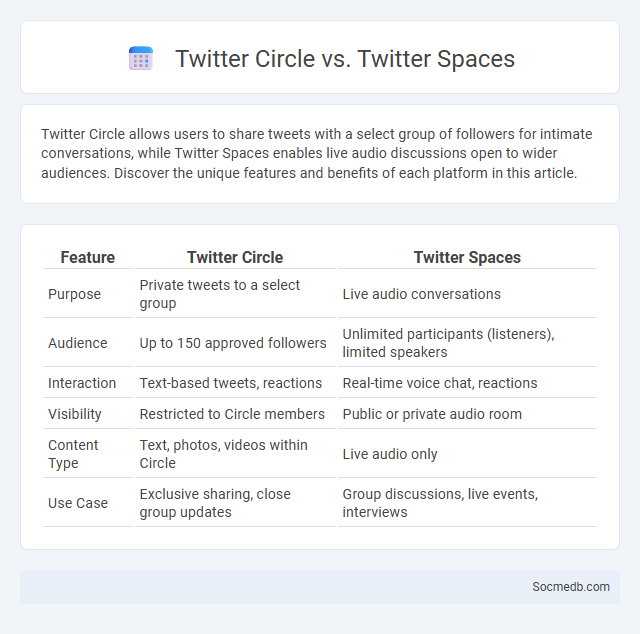
Photo illustration: Twitter Circle vs Twitter Spaces
Twitter Circle allows users to share tweets with a select group of followers for intimate conversations, while Twitter Spaces enables live audio discussions open to wider audiences. Discover the unique features and benefits of each platform in this article.
Table of Comparison
| Feature | Twitter Circle | Twitter Spaces |
|---|---|---|
| Purpose | Private tweets to a select group | Live audio conversations |
| Audience | Up to 150 approved followers | Unlimited participants (listeners), limited speakers |
| Interaction | Text-based tweets, reactions | Real-time voice chat, reactions |
| Visibility | Restricted to Circle members | Public or private audio room |
| Content Type | Text, photos, videos within Circle | Live audio only |
| Use Case | Exclusive sharing, close group updates | Group discussions, live events, interviews |
Overview: Twitter Circle vs Twitter Spaces
Twitter Circle offers a private way to share tweets with a selected group, enhancing your control over audience engagement and fostering intimate conversations. In contrast, Twitter Spaces provides a platform for real-time audio discussions, enabling you to host or join live conversations with a broader community. Both features expand your interaction options on Twitter by catering to different communication preferences and engagement styles.
What is Twitter Circle?
Twitter Circle is a feature that allows users to share tweets with a select group of up to 150 people, enhancing privacy and fostering more intimate conversations. It provides control over who can view specific content, distinguishing these tweets from public posts. This tool is designed to create a closer-knit community within the broader Twitter platform, facilitating targeted engagement.
What is Twitter Spaces?
Twitter Spaces is a live audio conversation feature integrated within the Twitter platform, enabling users to host and join real-time discussions on various topics. It supports interactive communication by allowing participants to speak, listen, and engage through voice in virtual rooms. This feature enhances social interaction by facilitating community-building and direct conversations beyond traditional tweets.
Key Features Comparison
Social media platforms differ significantly in key features such as user engagement tools, content formats, and privacy settings, influencing how you connect and share online. Instagram emphasizes visual content with features like Stories and Reels, while Twitter prioritizes short text updates and real-time conversations. Facebook offers extensive community-building options and integrated marketplaces, giving your social interactions a versatile and customizable experience.
Privacy and Audience Control
Social media platforms increasingly implement advanced privacy settings that empower users to control who can access their content, including options for custom audience selection and restricted sharing. These tools help protect personal information by allowing users to manage visibility at granular levels, such as friends, followers, or specific groups. Enhanced privacy controls reduce the risk of data breaches and unwanted exposure, fostering a safer online environment.
Use Cases: When to Use Twitter Circle
Twitter Circle is ideal for sharing content with a select group of followers, allowing you to tailor your messages to a specific audience without broadcasting to everyone. You can use it to engage more intimately with close friends, industry peers, or specific communities, enhancing targeted conversations and feedback. Your interactions become more meaningful as you control who sees your updates, making it perfect for sensitive topics, exclusive announcements, or niche discussions.
Use Cases: When to Use Twitter Spaces
Twitter Spaces is ideal for real-time audio conversations during live events, product launches, or Q&A sessions, enabling direct audience engagement. Brands can leverage Twitter Spaces to host interactive discussions, gather customer feedback, and build community through voice-driven content. This platform suits situations requiring immediate dialogue, such as breaking news coverage or expert panels, enhancing connection and authenticity.
Engagement and Interaction Differences
Social media platforms vary significantly in engagement and interaction, with Instagram prioritizing visual content that drives higher likes and comments through stories and reels. Twitter excels in real-time conversations and quick interactions via retweets and hashtags, fostering dynamic public discourse. LinkedIn emphasizes professional networking and in-depth discussions, promoting meaningful connections through posts and group interactions.
Pros and Cons: Twitter Circle vs Twitter Spaces
Twitter Circle lets you share tweets with a select group, enhancing privacy and focused engagement, while Twitter Spaces offers real-time audio conversations that boost interactive community building. Your choice depends on whether you prioritize controlled, intimate sharing or dynamic, public discussions. Both features expand Twitter's versatility but require mindful moderation to avoid privacy risks and ensure respectful dialogue.
Which One Should You Choose?
Choosing the right social media platform depends on your target audience, content type, and business goals. Instagram excels for visual content and brand engagement among younger demographics, while LinkedIn is ideal for B2B networking and professional growth. Facebook offers extensive reach with diverse user demographics, making it suitable for broad marketing campaigns and community building.
 socmedb.com
socmedb.com